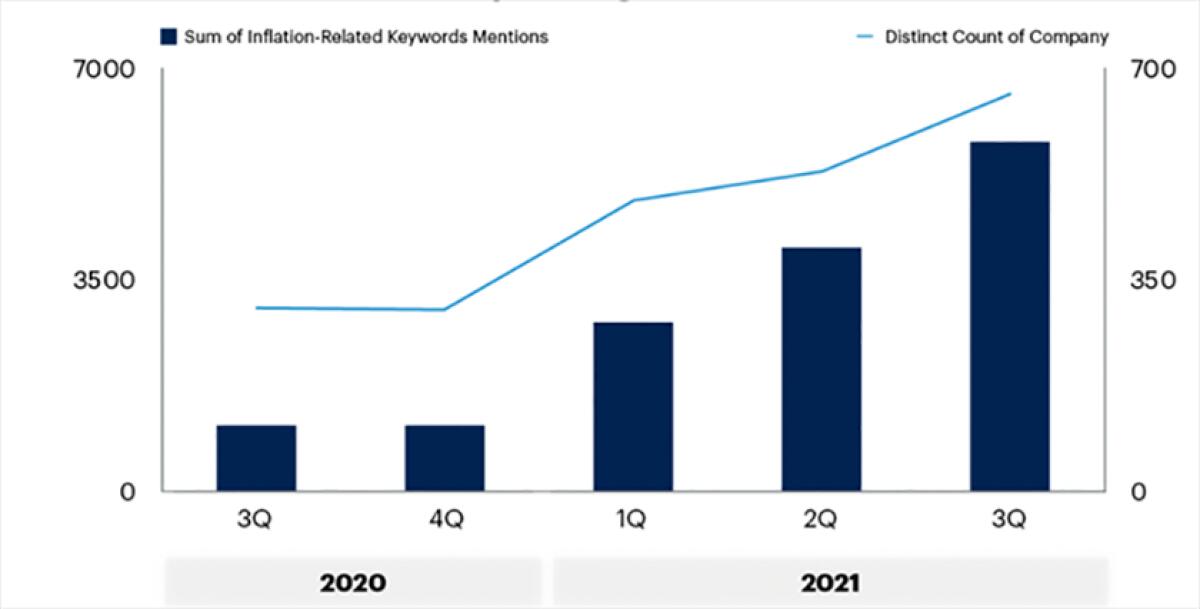Earnings Calls Increasingly Focus on the Topic of Inflation

- Share via
CFOs are finding themselves having to account for inflation-related uncertainties in annual budgets and offer guidance for investors, according to an analysis of S&P 1200 company earnings call transcripts from 3Q20 through 3Q21, says Gartner, Inc.
“Rising inflation and persistent supply chain issues are adding a new layer of complexity as CFOs and their business partners develop forecasts for the upcoming year,” said Vince Keenan, senior director, research in the Gartner Finance practice. “CFOs will need to account for the higher level of uncertainty as they set budgets that drive investment, compensation and annual guidance shared with investors.” In earnings calls for the 3Q20 through 3Q21 period, the number of companies mentioning inflation doubled from around 350 to just under 700, leading to an eightfold rise in keywords relating to inflation from around 850 to 7,000 (see Figure 1).

“Right now, forecasts for many industries will include volatile inputs that may significantly change the forecasts that companies share with the investment community,” said Keenan. “Withdrawing guidance altogether is a drastic response that poses its own risks. Sell-side analysts rely on the company’s annual guidance to develop quarterly estimates that companies will be measured against on future earnings calls.” Rather than avoid the topic, Gartner experts recommend four steps to quantify inflation risks and communicate their potential impact to the investment community.
Identify key business model assumptions that can impact financial performance in 2022: The finance team should reach out to business leaders in HR, product management, procurement, and operations to ensure they have accounted for risks that could increase costs and/or negatively impact revenue. These risks may stem from labor-related variables, such as use of recruiters and agencies, temporary staff or overtime, and one-off bonuses or product-related variables, such as commodity prices, component availability, transportation and so on.
In addition, CFOs should incorporate expert-vetted price assumptions into their forecasting processes. In the absence of third-party indexes, there may be available government data that correlated to the wage or input cost inflation companies are experiencing.
“With many cost factors outside the CFO’s control, pointing investors to third party data sources allows management to provide investors insight into cost drivers without making predictions,” said Keenan. “The goal is to educate investors on external risk while emphasizing the steps the company is taking to mitigate them.”
Stress test your forecast: Once finance has identified key inputs that could impact the business model, FP&A should perform a stress test to understand the most impactful high-risk variables.
The analysis should quantify the impact of key variables on the most important financial metrics - including revenue, gross profit margin and operating income margin - to isolate the risk to revenue and EPS forecasts.
In addition to cost, companies should also evaluate price elasticity in their markets as the ability to pass on price increases could vary across their customer base. Develop scenarios that isolate high-risk variables: Now that finance has identified the highest risk variables, it should develop scenarios for one to three assumptions that show potential outcomes. Such scenarios should incorporate the impact of any mitigation plans or cost reduction activities companies are taking, so they can isolate how much of the negative impact they can offset in the upcoming year.
For example, a logistics company might assume that for every 10% increase in fuel prices, their operating margin would decline by 100 to 150 basis points. Educate investors about external factors that could require an update to guidance: When providing guidance, management teams should acknowledge the variables that could have the greatest impact on their financial performance, both positive and negative. Other points to include in communications are demand dynamics, supply chain issues, mitigation plans and key metrics or indexes that could change the highlighted variables.
CFOs should supplement guidance with the scenario analysis to educate investors on which input factors have the biggest impact, as well as the degree of that impact. If there is an index or government-published statistic that tracks a key input, it should be shared with investors so they can monitor it.
“By educating investors of the risks to the forecast, a change in guidance will not surprise investors, and sell-side analysts will be better prepared to adjust their models if necessary,” said Keenan.
To learn more, visit gartner.com.